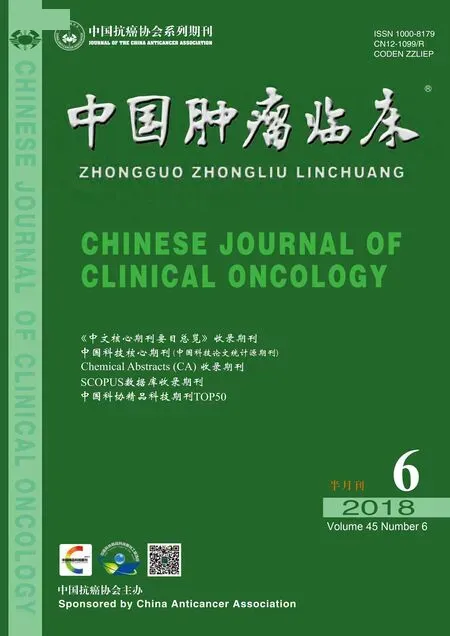骨肉瘤相关的lncRNA研究进展*
白广建 韩智涛 刘戈 陈广辉 信保全 刘铁龙
骨肉瘤是最常见的原发性恶性骨肿瘤,发生率为4.4/100万。在美国,骨肉瘤占青少年恶性骨肿瘤的56%以上[1]。由于骨肉瘤具有恶性程度高、生长迅速、侵袭力强、转移早等肿瘤学特征,其恶性生物学行为演变过程的分子机制研究已经成为国内外骨肉瘤基础研究的焦点。肺癌转移相关转录本1(MALAT1)的发现提示lncRNA与肿瘤的发生发展密切相关[2]。当对lncRNA的进行深入了解时,不仅可以发现lncRNA与肿瘤的紧密联系,还可以由此来寻找治疗骨肉瘤等其他癌症的一个新的分子机制靶点。本文就骨肉瘤相关lncRNA的研究进展进行综述。
1 骨肉瘤和lnc-RNA概述
骨肉瘤主要好发于青少年长骨的干骺端,这与青春期股骨远端和胫骨近端的骨骺生长板生长迅速有关[3]。除在青少年多发之外,在60岁以上的人群中骨肉瘤会出现第二个发病高峰[4]。有研究资料显示,青少年中女性的发病年龄较男性提前1~2年,这与女性较早进入青春期及其青春期的生长速度较快有关,即在青春期的骨骼生长和激素的变化可能有助于骨肉瘤的发生发展[5]。近年,外科治疗及新辅助化疗取得了长足的进展,使患者的5年生存率有了一定的提高,但多数患者最终死于局部复发或远处转移[6]。据报道,骨肉瘤的转移发生较早,20%在明确诊断时已有转移,且90%的转移灶发生在肺部[7-8]。由于骨肉瘤具有恶性程度高、生长迅速、侵袭力强、转移早等肿瘤学特征,其恶性生物学行为演变过程的分子机制研究已经成为国内外骨肉瘤基础研究的焦点。然而,目前对这一分子机制的了解还非常有限,这已成为骨肉瘤基础研究与临床治疗的瓶颈。
lncRNA是长度>200个核苷酸的非编码RNA,虽然不能直接编码蛋白质,但其可以在转录或者转录后水平调节基因的表达,从而实现生物学功能[9-10]。ln⁃cRNA可以通过不同的机制调节基因的表达量,包括表观遗传沉默、mRNA剪接、lncRNA-miRNA互作机制、ln⁃cRNA-蛋白互作机制与lncRNA-mRNA互作机制等来调节[11]。研究证实,lncRNA广泛参与细胞的生物学行为,如细胞增殖、细胞周期、生长和凋亡等过程[12]。
2 lncRNA与骨肉瘤
2.1 骨肉瘤中lnc-RNA表达谱
随着对lncRNA研究的深入,大量证据揭示了ln⁃cRNA的上调或者下调与骨肉瘤的发生发展等机制有密切联系。lncRNA表达谱的分析为阐明lncRNA在骨肉瘤中的功能开辟了新的思路。Li等[13]首次对骨肉瘤相关的lncRNA、表达谱进行探索。利用基因芯片技术对9对骨肉瘤及毗邻非癌样本进行检测,发现共有25 733个lncRNA在骨肉瘤样本中表达,其中403个lncRNA表达上调,798个lncRNA表达下调。生物信息学分析显示,34条信号通道活性变化与ln⁃cRNA表达上调有关,32条信号通路活性变化与ln⁃cRNA表达下调有关。Zhu等[14]利用基因芯片技术,对具有耐药性的MG63/DXR细胞系中的3 465个ln⁃cRNA进行检测,发现1 761个lncRNA表达升高,1 704个lncRNA表达下降,进一步的研究发现,部分ln⁃cRNA影响骨肉瘤细胞对药物的敏感性,并与AB⁃CB1、HIF1A和FOXC2基因的表达调控有着密切的关联。因此,研究骨肉瘤中lncRNA的生物学作用有助于彻底阐明骨肉瘤发生发展的分子机制。
2.2 lncRNA与骨肉瘤的增殖
2.2.1 促进骨肉瘤增殖的lncRNA 在骨肉细胞中,表达升高的lncRNA往往对细胞的增值起促进作用。Yin等[15]发现lncRNA-MFI2在骨肉瘤中表达升高,而沉默lncRNA-MFI2的表达会抑制骨肉瘤细胞系的细胞增殖并诱导细胞凋亡。同时发现,在骨肉瘤组织中,具有促进细胞增殖作用的的叉头框P4蛋白(FOXP4)的表达水平与lncRNA-MFI2表达量呈正相关。因此推测,lncRNA-MFI2可能通过上调FOXP的表达促进骨肉瘤的细胞增殖。Sun等[16]发现在骨肉瘤中,lncRNA-bx537709通过与FGFR3 mRNA形成了1 053个完全互补的“尾-尾”配对模式从而增加FGFR3 mRNA的稳定性,研究者将这条lncRNA称作FGFR3的反义转录本1(FGFR3-AS1)。实验中沉默FGFR3-AS1的表达可降低FGFR3 mRNA表达水平,抑制细胞增殖;反之,结果相反。类似该种“反义转录本结构”发挥作用的还有 lncRNA-SATB2-AS1[17]和 ln⁃cRNA-HNF1A-AS1[18]。
Hua等[19]在MG63细胞系中抑制 lncRNA-HO⁃TAIR的表达后,抑制凋亡的TGF-β和Bcl-2表达下调,而促进凋亡的p53和TNF-α表达明显上调,这说明lncRNA-HOTAIR可以促进骨肉瘤的细胞增殖。有研究显示lncRNA-ak093407[20]也可通过下调周期促凋亡蛋白Caspase-3的表达来促进骨肉瘤的增殖。
lncRNA除了通过调节周期蛋白影响骨肉瘤的发病机制,还可以通过影响miRNA的活性促进骨肉瘤的发生发展,如通过 lncRNATUG1-miR153[21]、lncRNAXist-mir320b-RAP2B[22]、lncRNA-ATB-mir200-ZEB1/ZEB2[23]等调控轴对骨肿瘤的增殖发挥作用。
2.2.2 抑制骨肉瘤增殖的lncRNA Cong等[24]通过对82例骨肉瘤样本的lncRNA-TUSC7进行检测,结果显示在骨肉瘤组织中其表达量明显低于癌旁组织,研究分析显示,骨肉瘤中lncRNA-TUSC7的表达与术后复发率呈负相关。在随后的研究中,高表达的lncRNA-TUSC7伴随着Bcl-2表达水平的提高,这提示在骨肉瘤的增殖机制中,lncRNA-TUSC7发挥了关键因素。总之,关于lncRNA影响骨肉瘤发生发展机制的研究是该领域研究的热点,不同的致/抑癌基因及其靶基因之间的相互作用网络的广泛性、复杂性,需要深入发掘和讨论。
2.3 lncRNA与骨肉瘤的侵袭和转移
2.3.1 促进骨肉瘤侵袭和转移的lncRNA lncRNA在骨肉瘤的发生、发展中发挥重要作用,近来研究表明,lncRNA在肿瘤侵袭和转移中也发挥重要作用,如lncRNA-BANCR[25]。lncRNA可通过调节部分基因的表达从而促进骨肉瘤的侵袭性,如lncRNA-HOTAIRMMP2/MMP9[26]、lncRNA-SNHG12-AMOT[27]、lncRNAMALAT1-EZH-E-cadherin[28]调控轴。Li等[29]通过对135例骨肉瘤样本及多种骨肉瘤细胞系中lncRNAUCA1的表达进行分析,结果表明其表达明显高于癌旁组织,MG-63细胞系中其表达最高,HOS细胞系中表达水平相对较低。RNA干扰技术下,下调的lncRNAUCA1阻碍了MG-63细胞的侵袭/迁移;上调lncRNAUCA1促进HOS细胞系侵袭/迁移的能力。
Chen等[30]对60例骨肉瘤组织及瘤旁正常组织研究发现lnc RNA BCAR4的表达在骨肉瘤组织中明显上调。同时临床资料显示lncRNA-BCAR4与骨肉瘤临床分期存在密切关系。随后,研究者上调ln⁃cRNA-BCAR4的表达,发现GLI2及其靶基因RPS3、IL-6、MUC5AC和TGF-β1的表达量均显著下降。已有报道指出[31-33],GLI2作为Sonic Hedgehog信号通路中的关键中介物,可显著的促进肿瘤的发生与转移。揭示了lncRNA-BCAR4-GLI2-Sonic Hedgehog调控轴在骨肉瘤分子机制的重要性。HIF2α的上游启动子lncRNA-HIF2PUT可以调控宿主编码蛋白基因(PCGs)的转录活性影响自身表达[34-37]。有研究证实HIF2α与肿瘤细胞甚至肿瘤干细胞的生长抑制有关[38-39]。研究显示上调的lncRNA-HIF2PUT不仅可以明显促进骨肉瘤细胞的凋亡[40];其表达水平可对远处转移、分化和侵袭深度具有明显的预测作用[41]。
2.3.2 抑制骨肉瘤的侵袭和转移的lncRNA Tian等[42]通过对64例骨肉瘤进行qRT-PCR检测及临床资料特征的单因素分析,发现lncRNA-MEG3在骨肉瘤起抑癌作用,并且与骨肉瘤的临床分期、远处转移及术后生存率有密切联系,认为lncRNA-MEG3可作为研究骨肉瘤的潜在的生物标志物,其具体的分子机制仍需进一步的研究探索。同样对骨肉瘤的侵袭和转移有抑制作用的还包括loc285194等[43]。总之,阐明与转移相关机制的作用靶点并探究靶向治疗以期控制骨肉瘤的转移对改善骨肉瘤患者的预后有着重大的意义。
2.4 lncRNA与骨肉瘤化疗
目前,骨肉瘤的治疗主要以手术切除为主并辅以术后化疗,但由于不同个体之间骨肉瘤细胞对化疗药物的敏感性不同而使化疗效果并不理想。所以,将ln⁃cRNA与肿瘤耐药性相结合来探讨其对骨肉瘤的作用机制,为骨肉瘤的治疗方法指引了一个新的方向。Zhang等[44]利用lncRNA基因组芯片技术筛选出促进骨肉瘤对阿霉素产生耐药性的相关lncRNA(ln⁃cRNA-ODRUL)。lncRNA-ODRUL可以上调经典耐药相关性ABCB1基因,增加骨肉瘤对阿霉素的耐药性,抑制癌细胞的凋亡。Wang等[45]提出FOXC2-AS1可通过提高FOXC2的表达,进一步上调ABCB1表达水平来提高骨肉瘤对阿霉素耐药性。也有资料显示lncRNA-CTA[46]可以通过抑制细胞自噬提高骨肉瘤组织对阿霉素的敏感性。随后Wang等[47]提出ln⁃cRNA-LINC00161-miRNA645-IFIT2调控轴的存在。lncRNA LINC00161可发挥“miRNA645海绵”的作用,抑制miRNA645的活性,上调IFIT2(干扰素诱导蛋白2),提高骨肉瘤细胞对化疗药物顺铂敏感性,诱导肿瘤细胞凋亡。化疗作为一种辅助治疗为骨肉瘤术后患者提供了新的希望,更多地了解lncRNA对化疗药物的影响将使得化疗的精准性得到提高。
2.5 循环lncRNA作为骨肉瘤的生物标志物
Ma等[48]分别对骨肉瘤患者术前及术后、术后复发患者、对照志愿者血清中lncRNA-TUG1的表达情况进行分析,发现术前血清中lncRNA-TUG1表达量较术后患者及健康志愿者显著增高。并且预后较差的患者血清lncRNA-TUG1表达量较预后良好者明显提高。
Huo等[28]发现骨肉瘤患者血清中lncRNA-MALAT1的表达水平在较健康个体显著升高,并且与肿瘤大小及远处转移有明显联系。联合血清lncRNA-MALAT1、ALP的AUC检查可将诊断敏感率及特异率分别由80.84%和72.5%提高到82.61%和82.50%。
所以,lncRNA不仅可作为判断骨肉瘤预后的生物标志,还可作为骨肉瘤诊断的一种新型无创性生物学指标。
3 小结
综上所述,众多的研究结果已经证实,lncRNA可通过多种方式参与骨肉瘤的增殖、迁移和侵袭,但我们必须清醒地认识到,关于骨肉瘤的lncRNA的分子水平研究也仅仅处于起步阶段,具体机制还有待于进一步研究。鉴于lncRNA在骨肉瘤诊断及治疗中存在的潜能,通过确定lncRNA在骨肉瘤治疗中的作用靶点,可为骨肉瘤的治疗提供一种新的手段。
[1]Geller DS,Gorlick R.Osteosarcoma:a review of diagnosis,manage‐ment,and treatment strategies[J].Clin Adv Hematol,2010,8(10):705‐718.
[2]Hua Z,Chen Z,Wang X,et al.Long non‐coding RNA:a new player in cancer[J].J Hemat Oncol,2013,6(1):37.
[3]Broadhead ML,Clark JC,Myers DE,et al.The molecular pathogenesis of osteosarcoma:a review[J].Sarcoma,2011,2011:959248.
[4]Mirabello L,Troisi RJ,Savage SA.Osteosarcoma incidence and survival rates from 1973 to 2004:data from the surveillance,epidemiology,and end results program[J].Cancer,2009,115(7):1531‐1543.
[5]Cotterill SJ,Wright CM,Pearce MS,et al.Stature of young people with malignant bone tumors[J].Pediatric Blood Cancer,2004,42(1):59‐63.
[6]赵晓蕾,蔡林,邓洲铭.microRNA与骨肉瘤的研究进展[J].中国骨与关节杂志,2014,3(10):773‐778.
[7]Wesolowski R,Budd GT.Use of chemotherapy for patients with bone and soft‐tissue sarcomas[J].Cleve Clin J Med,2010,77(Suppl 1):23‐26.
[8]Chou AJ,Kleinerman ES,Krailo MD,et al.Addition of muramyl tri‐peptide to chemotherapy for patients with newly diagnosed meta‐static osteosarcoma[J].Cancer,2009,115(22):5339‐5348.
[9]Guttman M,Rinn JL.Modular regulatory principles of large non‐coding RNAs[J].Nature,2012,482(7385):339‐346.
[10]Cheetham SW,Gruhl F,Mattick JS,et al.Long noncoding RNAs and the genetics of cancer[J].Br J Cancer,2013,108(12):2419‐2425.
[11]Gibb EA,Brown CJ,Wan LL.The functional role of long non‐coding RNA in human carcinomas[J].Mole Cancer,2011,10(1):38.
[12]Mercer TR,Dinger ME,Mattick JS.Long non‐coding RNAs:insights into functions[J].Nat Rev Gene,2009,10(3):155‐159.
[13]Li JP,Liu LH,Li J,et al.Microarray expression profile of long noncoding RNAs in human osteosarcoma[J].BiochemBio Res Commun,2013,433(2):200.
[14]Zhu KP,Zhang CL,Shen GQ,et al.Long noncoding RNA expression profiles of the doxorubicin‐resistant human osteosarcoma cell line MG63/DXR and its parental cell line MG63 as ascertained by micro‐array analysis.[J].Int J Clin Exp Path,2015,8(8):8754.
[15]Yin Z,Ding H,He E,et al.Overexpression of long non‐coding RNA MFI2 promotes cell proliferation and suppresses apoptosis in human os‐teosarcoma[J].Onco Rep,2016,36(4):2033‐2040.
[16]Sun J,Wang X,Fu C,et al.Long noncoding RNA FGFR3‐AS1 promotes osteosarcoma growth through regulating its natural antisense tran‐script FGFR3[J].Mole Biol Rep,2016,43(5):427‐436.
[17]Liu SH,Zhu JW,Xu HH,et al.A novel antisense long non‐coding RNA SATB2‐AS1 overexpresses in osteosarcoma and increases cell prolif‐eration and growth[J].Mole Cell Bio,2017,430(1‐2):1‐10.
[18]Zhao H,Hou W,Tao J,et al.Upregulation of lncRNA HNF1A‐AS1 promotes cell proliferation and metastasis in osteosarcoma through activation of the Wnt/β‐catenin signaling pathway[J].Am J Trans Res,2016,8(8):3503.
[19]Hua Z,Jing M.Role of long noncoding RNA HOTAIR in the growth and apoptosis of osteosarcoma cell MG‐63[J].Biomed Res Int,2016,2016(6):5757641.
[20]Wang Y,Liang T,Wang Y,et al.Long non‐coding RNA AK093407 pro‐motes proliferation and inhibits apoptosis of human osteosarcoma cells via STAT3 activation[J].Am J Cancer Res,2017,7(4):892‐902.
[21]Wang H,Yu Y,Fan S,et al.Knockdown of long noncoding RNA TUG1 inhibits the proliferation and cellular invasion of osteosarcoma cells by sponging miR‐153[J].Oncol Res,2017,42(12):505.
[22]Lv GY,Yu Y,Fan S,et al.Knockdown of Long Noncoding RNA TUG1 Inhibits the Proliferation and Cellular Invasion of Osteosarcoma Cells By Sponging MiR‐153[J].Oncol Res,2017,4(12):721.
[23]Han F,Wang C,Wang Y,et al.Long noncoding RNA ATB promotes osteosarcoma cell proliferation,migration and invasion by suppressing miR‐200s[J].Am J Cancer Res,2017,7(4):770.
[24]Cong M,Li J,Jing R,et al.Long non‐coding RNA tumor suppressor candidate 7 functions as a tumor suppressor and inhibits proliferation in osteosarcoma[J].Tumor Biol,2016,37(7):9441‐9450.
[25]Peng ZQ,Lu RB,Xiao DM,et al.Increased expression of the lncRNA BANCR and its prognostic significance in human osteosarcoma[J].Gene Mole Res,2016,15(1):28.
[26]Bo W,Yun S,Yang Q,et al.Overexpression of long non‐coding RNA HOTAIR promotes tumor growth and metastasis in human osteo‐sarcoma[J].Mole Cells,2015,38(5):432‐440.
[27]Ruan W,Pei W,Feng S,et al.Long non‐coding RNA small nucleolar RNA host gene 12(SNHG12)promotes cell proliferation and migration by upregulating angiomotin gene expression in human osteosarcoma cells[J].Tumour Biol,2016,37(3):4065‐4073.
[28]Huo Y,Li Q,Wang X,et al.MALAT1 predicts poor survival in osteo‐sarcoma patients and promotes cell metastasis through associating with EZH2[J].Oncotarget,2017,8(29):46993‐47006.
[29]Li W,Xie P,Wen HR.Overexpression of lncRNA UCA1 promotes os‐teosarcoma progression and correlates with poor prognosis[J].J Bone Oncol,2016,5(2):80‐85.
[30]Chen F,Mo J,Zhang L.Long noncoding RNA BCAR4 promotes osteo‐sarcoma progression through activating GLI2‐dependent gene tran‐scription[J].Tumour Biol J Int Soci Oncodevelop Biol Medi,2016,37(10):1‐10.
[31]Yang W,Liu X,Choy E,et al.Targeting hedgehog‐GLI‐2 pathway in osteosarcoma[J].J Orthop Res Offi Pub Orthopa Res Soci,2013,31(3):502‐509.
[32]Thiyagarajan S,Bhatia N,Reaganshaw S,et al.Role of GLI2 tran‐scription factor in growth and tumorigenicity of prostate cells[J].Cancer Res,2007,67(22):10642‐10646.
[33]Nagao H,Ijiri K,Hirotsu M,et al.Role of GLI2 in the growth of human osteosarcoma[J].J Path,2011,224(2):169‐179.
[34]Preker P,Almvig K,Christensen MS,et al.PROMoter uPstream tran‐scripts share characteristics with mRNAs and are produced upstream of all three major types of mammalian promoters[J].Nucl Acids Res,2011,39(16):7179‐7193.
[35]Taft RJ,Kaplan CD,Simons C,et al.Evolution,biogenesis and function of promoter‐associated RNAs[J].Cell Cycle,2009,8(15):2332‐2338.
[36]Preker P,Nielsen J,Kammler S,et al.RNA Exosome depletion reveals transcription upstream of active human promoters[J].Sci,2008,322(5909):1851‐1854.
[37]Jacquier A.The complex eukaryotic transcriptome:unexpected per‐vasive transcription and novel small RNAs[J].Nat Rev Gene,2009,10(12):833.
[38]Acker T,Diez‐Juan A,Aragones J,et al.Genetic evidence for a tumor suppressor role of HIF‐2alpha[J].Cancer Cell,2005,8(2):131‐141.
[39]Li Z,Bao S,Wu Q,et al.Hypoxia‐inducible factors regulate tumorigenic capacity of glioma stem cells[J].Cancer Cell,2009,15(6):501‐513.
[40]Wang Y,Yao J,Meng H,et al.A novel long non‐coding RNA,hypoxia‐inducible factor‐2 promoter upstream transcript,functions as an in‐hibitor of osteosarcoma stemcells in vitro[J].Mole Med Rep,2015,11(4):2534‐2540.
[41]Li W,He X,Xue R,et al.Combined over‐expression of the hypoxia‐inducible factor 2 gene and its long non‐coding RNA predicts unfa‐vorable prognosis of patients with osteosarcoma[J].Path Res Prac,2016,212(10):861‐866.
[42]Tian ZZ,Guo XJ,Zhao YM,et al.Decreased expression of long non‐coding RNA MEG3 acts as a potential predictor biomarker in pro‐gression and poor prognosis of osteosarcoma[J].Int J Clin Exp Pathol,2014,8(11):15138‐15142.
[43]Qi P,Xu MD,Ni SJ,et al.Low expression of LOC285194 is associated with poor prognosis in colorectal cancer[J].J Trans Med,2013,11(1):122.
[44]Zhang CL,Zhu KP,Shen GQ,et al.A long non‐coding RNA contributes to doxorubicin resistance of osteosarcoma[J].Tumor Biol,2016,37(2):2737‐2748.
[45]Wang Y,Zhang L,Zheng X,et al.Long non‐coding RNA LINC00161 sensitizes osteosarcoma cells to cisplatin‐induced apoptosis by reg‐ulating the miR‐645‐IFIT2 axis[J].Cancer Letters,2016,382(2):137‐146.
[46]Zhang CL,Zhu KP,Ma XL.Antisense lncRNA FOXC2‐AS1 promotes doxorubicin resistance in osteosarcoma by increasing the expression of FOXC2[J].Cancer Lett,2017,396:66‐75.
[47]Wang Z,Liu Z,Song W.Long non‐coding RNA CTA sensitizes osteo‐sarcoma cells to doxorubicin through inhibition of autophagy[J].Oncotarget,2017,8(19):31465.
[48]Ma B,Li M,Zhang L,et al.Upregulation of long non‐coding RNA TUG1 correlates with poor prognosis and disease status in osteosarcoma[J].Tumour Biol,2015,37(4):1‐11.
[48]Huo Y,Li Q,Wang X,et al.MALAT1 predicts poor survival in osteo‐sarcoma patients and promotes cell metastasis through associating with EZH2[J].Oncotarget,2017,8(29):46993‐47006.

